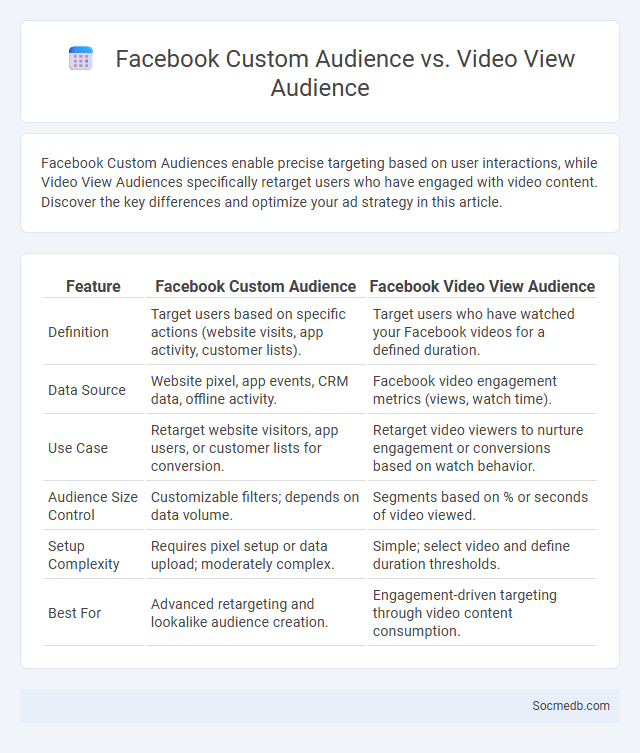
Photo illustration: Facebook Custom Audience vs Video View Audience
Facebook Custom Audiences enable precise targeting based on user interactions, while Video View Audiences specifically retarget users who have engaged with video content. Discover the key differences and optimize your ad strategy in this article.
Table of Comparison
| Feature | Facebook Custom Audience | Facebook Video View Audience |
|---|---|---|
| Definition | Target users based on specific actions (website visits, app activity, customer lists). | Target users who have watched your Facebook videos for a defined duration. |
| Data Source | Website pixel, app events, CRM data, offline activity. | Facebook video engagement metrics (views, watch time). |
| Use Case | Retarget website visitors, app users, or customer lists for conversion. | Retarget video viewers to nurture engagement or conversions based on watch behavior. |
| Audience Size Control | Customizable filters; depends on data volume. | Segments based on % or seconds of video viewed. |
| Setup Complexity | Requires pixel setup or data upload; moderately complex. | Simple; select video and define duration thresholds. |
| Best For | Advanced retargeting and lookalike audience creation. | Engagement-driven targeting through video content consumption. |
Introduction to Facebook Audiences
Facebook Audiences enable marketers to target specific groups based on demographics, interests, and behaviors, optimizing ad performance and engagement. Custom Audiences allow businesses to reconnect with existing customers by uploading contact lists or website traffic data. Lookalike Audiences expand reach by finding new users similar to existing high-value customers, enhancing campaign precision and ROI.
What is a Facebook Custom Audience?
A Facebook Custom Audience is a targeted advertising feature that allows businesses to reach specific groups based on existing customer data such as email addresses, phone numbers, or website activity. This tool enhances ad relevance by matching user information with Facebook profiles to deliver personalized campaigns. Marketers leverage Custom Audiences to increase conversion rates and improve return on ad spend by focusing on high-intent users.
Understanding Facebook Video View Audience
Understanding Facebook video view audience involves analyzing metrics such as watch time, engagement rate, and demographic insights to tailor content effectively. You can identify which segments of your audience are most engaged by reviewing data on age, location, and viewing devices. These insights help optimize video strategy to increase reach and foster deeper connections with your target viewers.
Key Differences Between Custom and Video View Audiences
Custom audiences allow you to target users based on specific actions or data like website visits, app activity, or customer lists, enabling highly personalized marketing campaigns. Video view audiences focus on users who have watched your videos, segmented by watch time or engagement, helping you reach viewers already familiar with your content. Understanding these key differences helps you tailor your advertising strategy to maximize Your campaign's relevance and effectiveness on social media platforms.
Audience Creation: Step-by-Step Comparisons
Audience creation on social media involves strategically defining and segmenting your potential followers based on demographics, interests, and behaviors to maximize engagement and ad performance. Utilizing platform-specific tools like Facebook Audience Insights and Twitter Analytics allows you to compare different audience segments side-by-side, optimizing your targeting strategy based on metrics such as age, location, and engagement levels. You can refine Your campaigns by analyzing these step-by-step comparisons to ensure your content reaches the most relevant and responsive audience efficiently.
Targeting Strategies for Each Audience Type
Effective social media targeting strategies vary by audience type, using demographic data such as age, gender, and location for broad targeting, while employing interests, behaviors, and engagement patterns to refine reach for niche groups. Utilizing advanced tools like Facebook Pixel, Instagram Insights, and LinkedIn Matched Audiences enhances precision by tracking user interactions and optimizing ad delivery. Custom and lookalike audiences further boost campaign performance by targeting users similar to existing customers, maximizing relevance and engagement.
Pros and Cons: Custom Audiences vs Video View Audiences
Custom Audiences offer precise targeting by leveraging your existing customer data, increasing ad relevance and conversion rates, while Video View Audiences enable you to reach engaged viewers based on specific video watch behavior, which helps expand brand awareness. Your choice depends on whether you want to retarget known users or attract new prospects through interest-driven engagement. Both methods have pros such as tailored messaging and improved ROI but cons include data privacy concerns and potential audience overlap limiting overall reach.
Best Practices for Audience Segmentation
Effective audience segmentation on social media requires analyzing demographic data, interests, and user behavior to tailor content that resonates with specific groups. Utilizing advanced analytics tools helps identify key audience segments, allowing you to craft personalized messages that boost engagement and conversion rates. Clear segmentation strategies enable your brand to deliver relevant content, optimize ad spend, and improve overall campaign performance.
Measuring Results: Performance Metrics Overview
Measuring results on social media involves tracking key performance metrics such as engagement rate, reach, impressions, and conversion rate to evaluate the effectiveness of your campaigns. Monitoring follower growth and click-through rates provides valuable insights into audience interaction and content resonance. By analyzing these data points, you can optimize strategies to enhance your social media impact and achieve your marketing goals.
Choosing the Right Audience for Your Campaign Goals
Selecting the right audience for your social media campaign is crucial to maximize engagement and conversion rates. Analyze demographics, interests, and online behaviors using platform-specific analytics tools such as Facebook Audience Insights or Twitter Analytics to refine targeting criteria. Tailoring content to match the preferences and pain points of your defined audience increases the effectiveness of campaigns and drives meaningful interactions.
 socmedb.com
socmedb.com